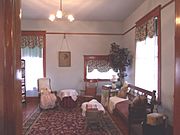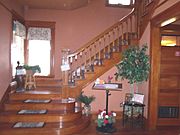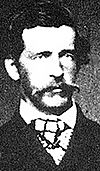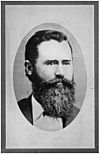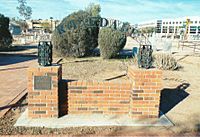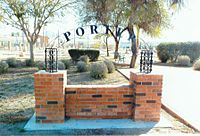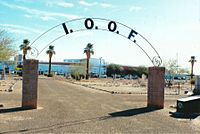Pioneer and Military Memorial Park facts for kids
Quick facts for kids |
|
|
Pioneer and Military Memorial Park
|
|
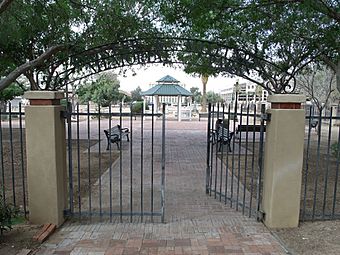
Main entrance of the Pioneer and Military Memorial Park
|
|
| Location | 1317 W. Jefferson Street Phoenix, Arizona |
|---|---|
| Built | 1884 |
| Website | Pioneers' Cemetery Association |
| NRHP reference No. | 06001317 |
| Added to NRHP | February 1, 2007 |
The Pioneer and Military Memorial Park is a special place in Phoenix, Arizona. It's actually the official name for seven old cemeteries that are all together. These cemeteries started way back in 1884.
On February 1, 2007, this area became known as the Pioneer and Military Memorial Park. It's so important that it's listed on the National Register of Historic Places. This means it's a historic site recognized by the United States government. The old Smurthwaite House, which is also historic, is right there too. It's used as the park's main office. Many important people from Arizona's past are buried here.
Contents
History of the Park
Before the Pioneer and Military Memorial Park was created, there were other cemeteries in Phoenix. Some of these started as early as 1850. People in the growing city became worried about an "old" cemetery. It was located near a new train station. They thought it might not look good to visitors arriving by train.
In 1884, the city leaders decided to buy a new area for a cemetery. This area was called "Block 32". Interestingly, archaeologists later found that this land used to be an ancient Hohokam community called "La Villa". Families moved their loved ones from the old cemetery to this new one. The city also reburied unclaimed bodies in a shared grave here.
One part of "Block 32" was bought by John R. Loosley. This section became known as the "City" or "Loosley" cemetery. Later, in 1888, Lulu G. Porter bought another part of "Block 32". She turned it into what is now called Porter cemetery.
Seven Historic Cemeteries
The "Block 32" area is made up of seven historic cemeteries. They were used between 1884 and 1914. Each cemetery has its own name:
- "Ancient Order of United Workmen" (AOUW)
- "Independent Order of Odd Fellows" (IOOF)
- "Knights of Pythias" (K of P)
- "Loosley" (also called City Cemetery)
- "Masons"
- "Porter"
- "Rosedale"
In 1914, a new law stopped burials within the city limits. So, these seven cemeteries were closed. For many years, they were not taken care of. But then, people in Phoenix worked hard to restore them. In May 1988, the restored cemeteries were officially named the "Pioneer and Military Memorial Park". It's believed that about 3,700 people are buried here. However, fewer than 600 of these graves have headstones.
The park is located between 13th and 15th Avenues and Jackson and Harrison Streets. You can find the main entrance at 1317 W. Jefferson Street.
Pioneers' Cemetery Association
In 1930, the Pioneers' Cemetery Association was started. This group began to preserve and restore the cemeteries. They also researched the history of the people buried there. Their work stopped for a while because of World War II and the death of their main researcher.
The current Pioneers' Cemetery Association was formed in 1983. They have continued the important work of preserving the park. They work closely with the City of Phoenix to keep the park special.
The Smurthwaite House
|
Smurthwaite House
|
|
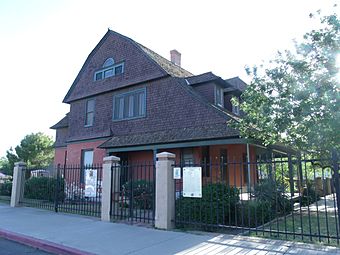
The Smurthwaite House
|
|
| Location | Originally located at 602 N. 7th Street moved to 1317 W. Jefferson Street Phoenix, Arizona |
|---|---|
| Built | 1897 |
| Architect | Creighton & Millard |
| Architectural style | Victorian |
| NRHP reference No. | 01000479 |
| Added to NRHP | May 17, 2001 |
The Smurthwaite House was built in 1897 by a local company called Creighton & Millard. It was first built for Dr. Darius M. Purman and his wife, Mary. The house was originally at 602 N. 7th Street and was meant to be a boarding house.
Over the years, the house had different owners. In 1903, Captain Trustrim Connell, who received the Medal of Honor, and his wife Ann bought it. Their daughter, Caroline Smurthwaite, later owned it. Her daughter, Carolann Smurthwaite, lived there until she passed away in 1982. Carolann wanted the house to be managed by three museums: the Phoenix Art Museum, The Museum of Northern Arizona, and the Heard Museum.
In 1991, money was approved to restore the Smurthwaite House. In 1994, the house was moved to its current spot at 1317 W. Jefferson Street. Today, it serves as the office for the Pioneer and Military Memorial Park.
Inside the Smurthwaite House, you can see an old map from 1885. It's called the "Bird's eye view of Phoenix, Maricopa Co., Arizona" and was made by Czar James Dyer. Dyer was even Phoenix's acting mayor in 1899.
- The interior furnishings and decorations of the Smurthwaite House.
-
The original lithograph of the "Bird's Eye view of Phoenix" map created by Czar J. Dyer is located inside the Smurthwaite House's main room.
Historic Places Recognition
Both the Smurthwaite House and the Pioneer and Military Memorial Park are very important historic sites. They are both listed on the National Register of Historic Places.
The Smurthwaite House was added to the Register on May 17, 2001. The Pioneer Military and Memorial Park was added on February 1, 2007. Being on this list means they are recognized for their historical importance.
Notable People Buried Here
Every year, the Pioneers’ Cemetery Association offers "Historic Cemetery Walking" tours. These tours highlight the graves of many important people buried in the park. Here are some of them:
Masons Cemetery
- John Taylor Alsap – He was the first Treasurer of the Arizona Territory. He also served as a leader in the Arizona Territorial legislature. In 1881, he became the first Mayor of Phoenix.
- Phillip "Lord" Darrell Duppa – This Englishman is famous for suggesting the names "Phoenix" and "Tempe" for cities in Arizona. He also founded the town of New River, Arizona.
City/Loosley Cemetery
- Henry Garfias – He was a Hispanic man who became the first marshal of Phoenix. He was also a skilled gunfighter.
- Jacob "Dutchman" Waltz – This German immigrant found a secret gold mine in Arizona. Its location is still a mystery, leading to the name "Lost Dutchman's Mine."
- King S. Woosley – He started one of the first flour mills in the Salt River Valley. He also served in the territorial government and opened Phoenix's first ice skating rink.
Rosedale Cemetery
- Benjamin Joseph Franklin – He was a U.S. Congressman from Missouri. Later, he became the 12th Territorial Governor of Arizona.
- Czar James Dyer – He served as a councilman and acting mayor of Phoenix. He also drew the famous "Bird's Eye view of Phoenix" map, which you can see in the Smurthwaite House.
- Noah M. Broadway – He was one of the first settlers of Phoenix. He was a farmer, a sheriff, and a veteran of the American Civil War. Broadway Road in Phoenix is named after him.
- J.W. Bolton – He was a barber and became the first African-American Mail carrier in Phoenix.
- Robert Plumridge – He was a soldier in the Union Army during the American Civil War. He fought in the Battle of Picacho Pass in Arizona.
Porter Cemetery
- Millard Lee Raymond – He was a Rough Rider in the Spanish-American War. His unit fought in Cuba under the command of Theodore Roosevelt.
Knights of Pythias & Ancient Order of United Workmen Cemetery
- Frederick E. Tovrea – He was the 10-year-old son of E. A. Tovrea, who owned a large cattle company and the famous "Tovrea Castle" in Phoenix.
- John Preston Osborn – He arrived in Arizona in 1854 and built the first hotel in Prescott. He later helped establish Phoenix, and Osborn Road in Phoenix is named after him.
- The Rossen Children – These were the children of Dr. Roland Rosson, whose historic house in Phoenix is also famous.
- William Augustus Hancock – He is known as the "Father of Phoenix." He planned the first town site of Phoenix in 1870 and served as the first sheriff of Maricopa County.
- Tom Graham – He was the last person killed in the Pleasant Valley War, a famous feud in Arizona history.
Independent Order of Odd Fellows Cemetery
- Lindley Orme – He was a former soldier in the Confederate Army. He later served in the territorial government and as Maricopa County sheriff.
- Frank B. Moss – He was the Mayor, Fire Chief, and a wagon maker in Phoenix. He died while serving as mayor.
Images for kids
-
Grave site of Jacob "Dutchman" Waltz located in the "City/Loosley Cemetery" section.
-
The grave of King S. Woolsey in the "City/Loosley Cemetery" section.
-
Grave site of Benjamin Joseph Franklin located in the "Rosedale Cemetery" section.
-
The grave of William Augustus Hancock in the "K of P & A.O.U.W. Cemetery" section.




